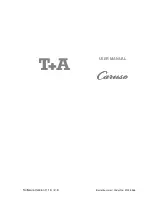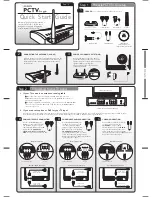
HELO Plus H.264 Streaming and Recording Encoder v1.0 58 www.aja.com
Viewing Recorded Files
Figure 11. Recordings Directory Headings with Data Transfer Mode Off
Trash
Button
Recording
Type and
Destination
Recording
Path
Data Transfer
Button (Off)
File Search
Filter
Selected
Clip
Remaining
Storage Capacity
Volume
Name
File
System
Information about the media is shown in the top heading, and information for the
clips on that media is listed below.
For each recorded file, you can view these characteristics:
• File Name
• Video Format
• Number of Audio Channels
• Duration
• File Size
• Date (YYYY-MM-DD HH:MM:SS AM/PM)
• Encode Type
Not all characteristics are available in the case of .m3u files.
The video file types displayed are .mov, mp4 and m3u (play list) files. For example,
if you have recorded one hour's worth of 5-minute segments, you will see 12
video files (for a total of one hour of video) and one m3u playlist file. m3u files are
text files that contain a list of all the segmented clips that go together.
When a recording starts, the clip name and m3u will appear in the listing. The
clip will show initial information, which will remain unchanged until recording is
complete. Once finished, it will be updated with the final file size and duration of
the complete recording. If the recording only contains a single segment, the .m3u
file is automatically deleted.
If HELO Plus detects an issue with a file, it will be listed in orange italic text.
Hovering over the file with the mouse will show a popup that gives more details
about the issue. One common issue is a clip that contains zero frames. This applies
to audio-only files not created by HELO Plus, so warnings for such files can be
safely ignored.
If a clip displays in orange italic text, you can check its validity using a computer.
Sorting Columns
You can sort the files by clicking any of the column headings.
Click a column heading to toggle sorting of the table by ascending or descending
order by that column. For example, repeatedly clicking the File Size column
header will alternately sort the table from largest file to smallest, then smallest to
largest.
Sorting can be slow if there are a large number of files in a folder. To improve
responsiveness, delete unwanted files and keep the number of files in a directory
to a few screens.
















































